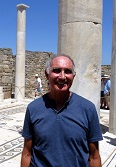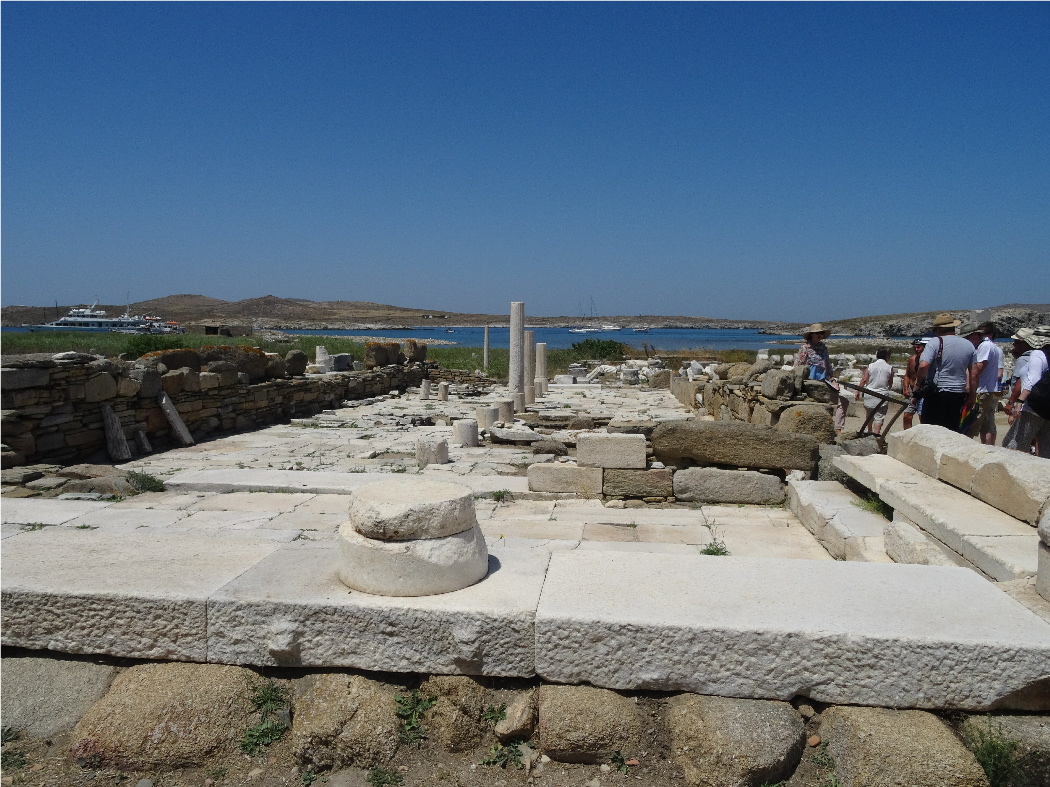


|
|
|
|||||||||||||||
|
|
||||||||||||||||
|
|
|||
|
|
Delos
Located two miles from the island of Mykonos is the small, barren, rocky island of Delos, five square km in size, and originally known as Ortygia (Quail Island). It contains an archaeological site which, according to Greek mythology, was the birthplace of the god Apollo and his twin sister Artemis. These were the children of Zeus by his mistress, Leto. Zeus’s jealous wife, Hera, banished Leto from earth but she was given sanctuary on Delos by Poseidon, where she gave birth to the twins. Delos is situated in the centre of The Cyclades, an archipelago of some 2,200 small islands in the southern part of the Aegean Sea. The island has been inhabited since 2500 BCE. In the 9th century BCE it was colonised by the Ionians who made it their religious capital. It became a sanctuary to Apollo and was one of the most sacred places of the ancient Greeks, second only in importance to Delphi. The site was covered with an assortment of temples and sanctuaries dedicated to a variety of gods. Because of Delos’ importance as a sacred religious centre, no mortal births or deaths were allowed to take place there. Anyone at risk of either was taken to the nearby island of Rineia. After the Persian Wars (499 to 449 BCE), the island became the meeting place for the Delian League, an alliance of Greek city-states led by Athens, which was founded in 478 BCE to liberate eastern Greek cities from Persian rule. The League maintained its treasury there until 454 BCE when it was moved to Athens by Pericles and was then based in the Acropolis. The island’s importance grew due to its being centrally located on the sea route between the Greek mainland and Asia, and because of its excellent harbours, protected as they were by the islands of the Cyclades. Delos reached its most affluent period during the late Hellenistic and early Roman times. In 167 BCE it was declared a free port, which increased its prosperity brought many foreigners to the city, who established many shrines and temples. Delos was used by multi-ethnic merchants who frequented separate centres and traded in numerous goods. It was also a major centre for the sale of slaves with thousands of slaves being traded daily. Things were to change in 88 BCE when Delos was sacked and looted by Mithridates, the King of Pontus, during his war against Rome. This assault resulted in the entire population, which was around 20,000 at that time, either being killed or sold into slavery, and the city being razed to the ground. It was partially rebuilt by the Romans but in 69 BCE it was once again attacked, this time by pirates, after which Delos fell into decline and was eventually abandoned. Over subsequent years, the island was repeatedly looted of its treasures until 1872 when formal excavation work was begun, work that is still going on today. The ruins of ancient Delos are on the western side of the island and extend north and south of the harbour along the coast. The Maritime Quarter, is located next to the harbour and was the main residential area when the city was at its peak. 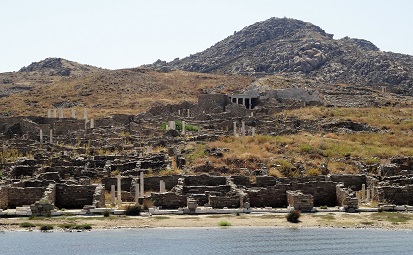 Inland from the harbour, is the Agora of the Competaliasts, a marketplace of Roman merchants, dating to 150 BCE. At its centre is a round shrine with a square base, upon which offerings were placed. Near to this and dating from the same time, is the Ionic Naiskos temple (shown in the main photo above) with a marble offertory box decorated with two snakes.  The Theatre District lies southeast from the harbour along one of the many roads leading from the harbour. The Theatre District contains the theatre which was originally built of marble taken from a neighbouring quarry and local stone, although marble was also imported from the islands of Paros and Tinos. Taking 70 years to construct it was completed in 250 BCE and held in excess of 5,500 people, providing them with splendid views over the harbour. 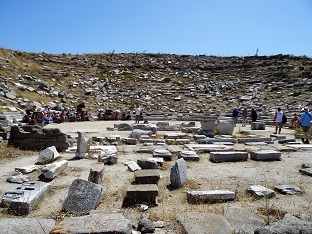 Surrounding the area are hundreds of unidentified stones removed from the building during the original excavations without being recorded or documented. Southwest of the theatre are the remains of altars and sanctuaries dedicated to Artemis, Apollo, Dionysos, Hermes and Pan. Nearby is The Theatre Cistern which collected rainwater from the cavea (the tiered semi-circular seating space of an ancient theatre.) via a duct running round the orchestra. The cisterns roof was supported on eight granite arches.  The Sanctuary of Apollo, which was the ancient heart of Delos was, and still is, its most important area. This is reached along the Sacred Way leading from the Agora. The Sacred Way is 45 feet wide, paved and lined with marble bases that once supported statues and monuments. This was the route that was used in ancient times by visiting pilgrims and for the annual religious procession. On the left side of the Sacred Way is the Stoa of Philip. A stoa is a portico, usually walled at the back and having a front colonnade, designed to provide a sheltered promenade. It was a gift to Apollo from Philip V of Macedon, the ruler of the Cyclades, in 200 BCE. It had 16 Doric columns of grey marble, of which only one still remains although the architrave with its dedicatory inscription has survived. On the right side of the Sacred Way is the South Stoa, built in the 3rd century BCE. The Sanctuary of Apollo contained a number of temples although little remains of them today other than a few columns and stones scattered around the ground. The entrance to the sanctuary from the Sacred Way was marked by the Propylaea, the monumental gateway, built in 150 BCE, with its three portals of white marble and supported by four Doric columns. 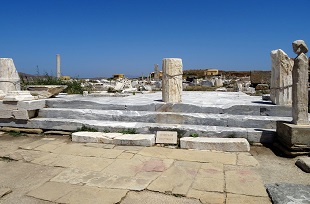 The Great Temple of Apollo, measuring 29.6m by 13.4m with six rows of 13 columns was begun around 477 BCE, but was not finished due to the treasury of the Delian League being transferred to Athens in 454 BCE, although it was finally completed in the 200’s BCE. Located next to the Great Temple was the Temple of the Athenians which was built between 425 and 417 BCE. 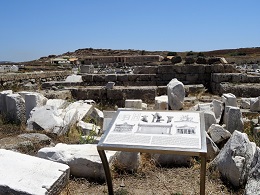 17.8 m by 11.4 m in size it had six Doric columns on the façade. It contained a semi-circular pedestal made of Eleusinian marble which held seven statues. It is believed that the temple housed the statue of Apollo. The third great temple in this area is the Porinos Naos, which was where the treasury of the Delian League was originally kept. 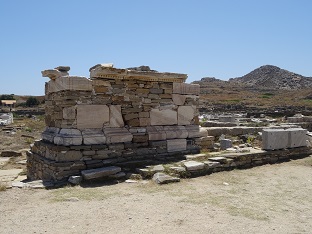 At the north end of the site is the Lion District, so named due to its Terrace of the Lions dating to the 7th century BCE. 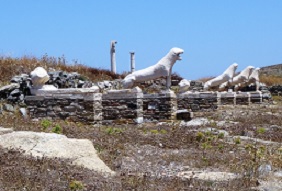 The Terrace contained nine lions made of Naxian marble which looked out onto the Sacred Lake and guarded the sanctuary. The lions seen today are replicas which replaced the originals, five of which are displayed in the on-site museum. The Sacred Lake, which the lions looked over, was where the sacred swans and geese of Apollo were kept. In the centre is a palm tree that was planted in honour of the one Leto is said to have clutched while giving birth to Apollo and Artemis. The lake was drained in 1926. By the lake is the 4-metre-deep Minoan Fountain which was built in the 6th century BCE. The column in the middle supported the roof and dates to the renovations of 166 BCE.  Behind the fountain is a small tourist centre which includes a restaurant and bar. Next to the restaurant is the Archaeological Museum which houses many of the artifacts that have been found at the site. Although a large quantity are now on display at the National Archaeological Museum in Athens. 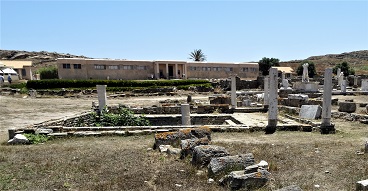 Excavation at Delos began in 1872 by the French School of Athens and is still going on. To accommodate the findings an onsite museum was build in 1904 with expansion occurring in 1931 and 1972. The artifacts on display include many statues such as the statue of Cybele, an Anatolian mother goddess. 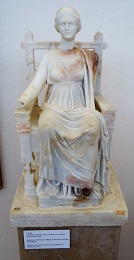 It also displays the Lions of Delos which used to stand on the Terrace of the Lions at the end of the Sacred Way. These were brought into the museum for protection but were replaced by replicas. It also displays the Lions of Delos which used to stand on the Terrace of the Lions at the end of the Sacred Way. These were brought into the museum for protection but were replaced by replicas. It also includes many of the objects found on the site. 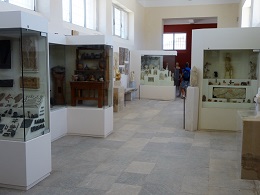 Delos contains the ruins of numerous villas, many of which contained extremely fine mosaics, some of which can still be seen. For example, the House of the Masks with its mosaic of Dionysus riding a panther, the House of Dionysus containing a mosaic of the god, and the House of the Dolphins, so named due to its mosaic of dolphins. Many other houses can be seen such as the House of Cleopatra (Kleopatra) which was owned by an Athenian, Dioskourides and his wife Kleopatra. It contains replica statues of them in the house. 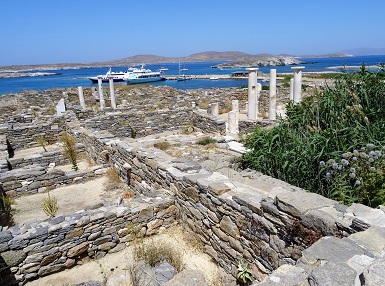 Another house which can be visited is the House of the Lake with its beautiful mosaic atrium. This was inhabited from roughly 300 to 100 BCE. The peristyle impluvium (the sunken part of the atrium in a Greek or Roman house).This is designed to carry away the rainwater coming through the space in the roof, it is decorated with a geometric-patterned motif around a central rosette, surrounded on all sides by monolithic columns in the Ionic style. 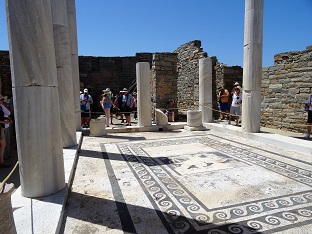 Delos became a UNESCO World Heritage Site in 1990.
|
|
|
|
|
|||
All Photographs were taken by and are copyright of Ron Gatepain
| Site Map |
